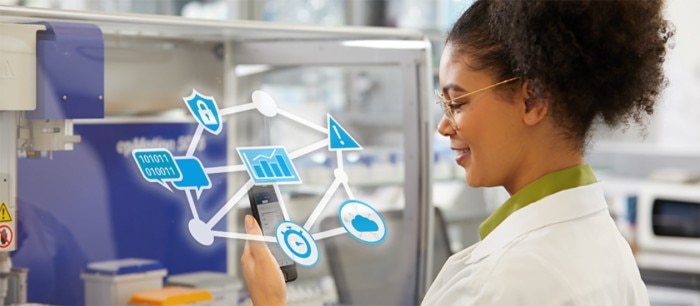MENU
HK | HKD
Logged in as:
HK | HKD
No results found
Search Suggestions

Laboratory of the future: What is a pipette doing in the cloud?
Lab Academy
- Pharma
- Biotechnology
- Health & Medicine
- Efficiency
- Digital Lab Solutions
- Automation
- Essay
The SARS-CoV-2 pandemic has a wide range of effects on laboratories around the world. And this does not (only) mean the current high number of requests for PCR tests for the new corona virus. In fact, laboratory work will change significantly and permanently in the future, estimates Dr. Christian Gill, Head of Emerging Business Opportunities at Eppendorf. "Right now, we believe that at some point in time we will have a laboratory that is almost free of personnel on location - just as we are already witnessing in other industries. It will never be entirely without people, but their permanent presence on site will no longer be necessary."
The Internet of Things (IoT) will play a decisive role in this, argues Gill. "For the time being, we are assuming that new equipment will be Internet-capable. This refers to the classic IoT readiness familiar from TV sets, for example. This is a very important enabler. However, it will be a challenge to enable existing equipment in the laboratories to be IoT-ready with a manageable amount of effort.
There were numerous starting points for further optimizing laboratories and for improving the use of existing assets through digital applications", says Gill. "This will not be accomplished by using physical calendars to reserve a device or a workstation, for example. These kinds of general administrative tasks are more efficiently solved in the form of asset management systems with visualization . In the second step, there will also be no need for a human on site to keep track of the status of a system. And in the third step, the instruments will become much more remotely controllable and manageable. So in the not too distant future, in an estimated 2-3 years, you will no longer need anyone to physically press a button to initiate a process. Initially, this will be about controlling the devices, while in the long term, robotics will play a major role", Gill assumes.
There were numerous starting points for further optimizing laboratories and for improving the use of existing assets through digital applications", says Gill. "This will not be accomplished by using physical calendars to reserve a device or a workstation, for example. These kinds of general administrative tasks are more efficiently solved in the form of asset management systems with visualization . In the second step, there will also be no need for a human on site to keep track of the status of a system. And in the third step, the instruments will become much more remotely controllable and manageable. So in the not too distant future, in an estimated 2-3 years, you will no longer need anyone to physically press a button to initiate a process. Initially, this will be about controlling the devices, while in the long term, robotics will play a major role", Gill assumes.
Read more
Read less

Sample and Workflow Management
A crucial precondition for extensive automation is to clearly identify the samples in all their different states. "Contextualizing the data related to the sample will be the next challenge. It is no longer sufficient to stick the barcode onto the tube once. Now it is a matter of tracking the states of the sample changing within the protocol". This could be accomplished in a few years, for example, with block chain, which is currently still too expensive. "In principle, however, this is the idea behind it: We continue to map the digital twin of the physical specimen. The next step towards a practically unmanned laboratory is the topic of workflows. Once I am able to configure my recipes or protocols step by step with all the dependencies on the devices and their respective states, all that is missing is a clever way to physically transport the samples. There are several possibilities, from linear guidance systems to robots, cobots or even drones."
Device Management
"Linking an electronic pipette to the cloud doesn't help much at first, but it does add real value once I can keep an eye on the condition of the pipette at all times. The fact that the researcher in charge and the laboratory manager can check at any time where the pipette is, in what condition it is and what its history is, adds interesting value in terms of topics such as calibration, quality management or audits", says Gill. "It becomes even more interesting if we are not only able to check the current actual state but can also turn the pipette into an extended arm of the software by loading it with the appropriate protocols. If we could load a protocol to be executed onto the pipette, this would almost turn the pipette into a small robot. In addition to the pipette's utilization, quality assurance in the sense of preventing errors will increasingly benefit from this. Documentation of the parameters is also an important point", Dr. Gill says: "Up to now, we have spent a lot of time manually documenting what we have done in the laboratory. We are now striving to ensure that no one in the laboratory has to worry about this anymore, because contextualized data is automatically recorded in the background. Thus, a relatively simple pipette will in future become an essential tool fulfilling a whole range of tasks from documentation to planning and execution to quality control."
Laboratory and Workflow Automation
At a time when more and more people are working from their home office, the question naturally arises as to whether this trend can also be transferred to laboratory work. Here, Gill says, there is a clear distinction to be made between various types of laboratories: "In research, extensive automation will always be difficult because there are no fixed protocols for repetitive tasks in place yet. This means that researchers work relatively much in the mode of trial & error and could at best reach a semi-automated level." To achieve total automation, highly complex tasks would have to be simplified to such an extent that sufficient standardization can be achieved. And the more one has to try out, the more difficult this becomes. For repetitive tasks, on the other hand, the degree of automation is basically dependent on economic considerations, says Gill: "When it comes to tests that are the same every time, such as the test for SARS-CoV-2, for which there is great demand, automation allows the cost per sample to be reduced."
A completely unmanned laboratory nevertheless remains an illusion, Gill is certain: "If, for example, the rotor of a centrifuge needs to be replaced, this cannot be fixed automatically. But with over-the-air updates and remote services, we are able to solve problems at the software level, play out optimizations or request maintenance tasks. Step by step, we will also increasingly integrate the instruments into workflows, for example to further improve documentation. The calibration process can also be automated. "Asset management not only can keep track of the history and current status, but also allows in the future a forecast of when the next calibration will be due. "Devices will soon be able to order spare parts before they break down, Gill is sure: "This is called predictive maintenance, comparable to the use-dependent warning messages on the display of modern cars. But for this to work reliably, devices and software must be perfectly aligned.” At Eppendorf, the focus of attention is therefore not only on the devices, but also on the Systems used in Laboratories. "Our strength is the digital portfolio with the corresponding application-related knowledge in the background. We are positioning ourselves in the orchestration of ecosystems and rely on an agnostic approach, so that we are able to integrate third-party systems and instruments into our software as well. This open approach to the systems is one of their strengths."
Read more
Read less

Standardization versus individualization
How far a laboratory can be automated depends on specific tasks. The extremes are automated laboratory lines and manual research benches, explains Gill, who is responsible for the development of new, all-digital products under Eppendorf's "VisioNize® " brand: "We understand our part to be between highly standardized laboratory notebooks on the one hand and highly individualized LIM systems on the other, i.e. the combination of customized and semi-standardized analyses. The development has already begun, starting with the IoT readiness and device software interfaces. "At the same time the man-machine interface is also being developed. How easily can I correctly operate something from the start, without any training, without any introduction, without a so-called learning curve? Ultimately, the aim is to create such simple, intuitive operability by optimizing the interfaces between employee, machine and software that instruction or training are no longer necessary, says Gill. We have an entire department working on this topic", explains the conceptual head: This would be not only be decisive for new products, but also for existing systems that are already on the market.
Quality of results will benefit
Gill thinks that in the laboratory of the future, the quality of results could also benefit from a reduction in human influence when performing repetitive tasks: "While in research and development the human factor is becoming more important, we will free ourselves from highly repetitive, tiring and boring routines. In other words, we will use our minds more and more, replacing tedious administrative and repetitive steps with varying degrees of automation with a lower error rate."
Read more
Read less
